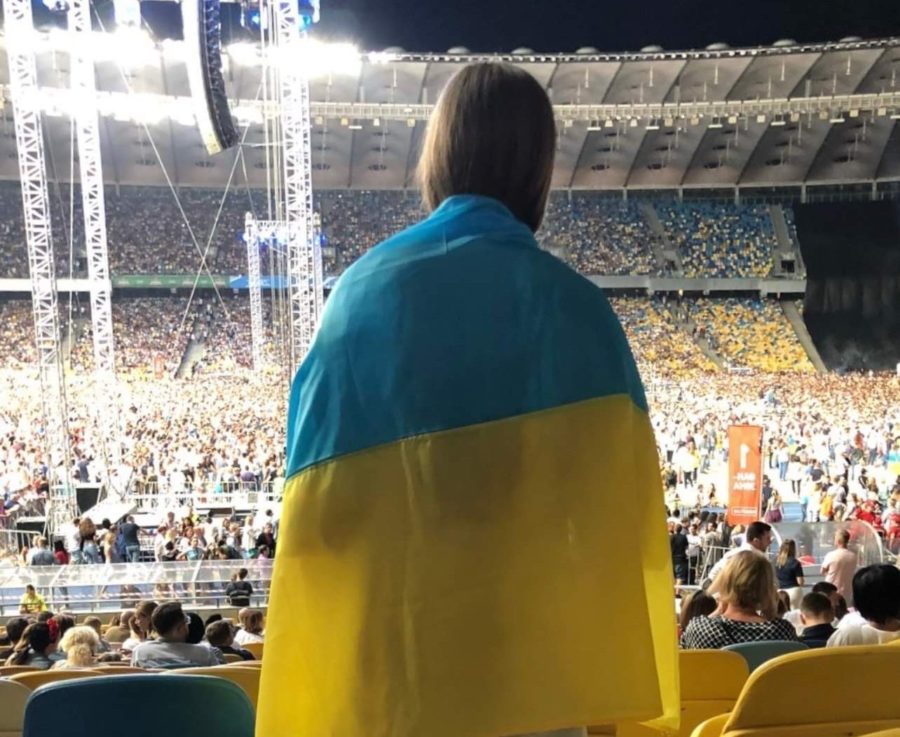There’s more to Ukraine than an imminent invasion
A message from a Ukrainian student who loves her country
Photo courtesy Sonya Rashkovan
Junior Sonya Rashkovan attends a concert in Ukraine for the country’s Independence Day in 2018.
February 22, 2022
“Sonya, how are you doing?”
“Can you stay after class?”
“Can you explain the situation in Ukraine to me?”
As one of the few Ukrainian students at Whitman, my teachers and classmates have asked me countless questions about the geopolitical situation in my home country over the past several months. I’ve had these conversations since Russia’s increase of their troop presence on Ukraine’s borders made global headlines this past November, but the discussions intensified tenfold when the threat of a Russian invasion became more severe in late January.
I was born in Ukraine and lived there for 12 years. Even though I moved to the United States in seventh grade, I visit my relatives and friends in the country every summer. I’ve planned my adulthood around returning to Ukraine after college.
When I take time to explain the situation in Ukraine to teachers and friends, I hit all of the rational points that I feel like I need to: Russia has been at war with Ukraine since 2014. That year, the West and NATO deserted Ukraine when Russia annexed Crimea — a peninsula in southern Ukraine — and part of easternmost Ukraine. Russia’s aggression has since led to the displacement of more than one million Ukrainians and the deaths of more than 14 thousand individuals in my country.
Ukrainians fought back — not only for the independence and prosperity of their country but also for security throughout Europe. Ukraine is the largest country in Europe, so the war isn’t only a Ukrainian-Russian conflict: it’s a crisis that has affected all of Europe and the world.
I want to believe that Russia’s threats of invasion are merely part of the “brinkmanship” game between Russia and the West. I want to believe that they won’t turn into a reality. But, every day when I listen to NPR’s “Up First” podcast or have late-night discussions with my parents, I can’t ignore the likelihood of a new full-scale war in my country. One morning last week I realized that I couldn’t listen to or read any news about the situation in Ukraine without getting tears in my eyes.
U.S. intelligence documents include maps with arrows pointing at potential Russian invasion paths. Looking at the images, most Americans may only see routes for military equipment and personnel, but on those maps, I see the cities where I grew up and the streets I walked as a child. Thinking about the potential destruction of Ukrainian local businesses, residential blocks and schools — and my childhood memories — is devastating.
I represent my country everywhere I go. For most of the time I’ve lived in America, I’ve loved discussing my country with others, since I realize that I might be one of the only Ukrainians my classmates will come across in their lives. But recently, answering my friends’ questions about the war has caused a storm of anxiety inside me.
U.S. officials have said that the Russian invasion may lead to the deaths of over 50,000 Ukrainian civilians. For me, that isn’t just an unimaginable number, but the faces of my friends, my relatives and common citizens like myself.
Some potential Russian invasion paths include the beautiful city of Odesa, in southern Ukraine by the Black Sea. Odesa is my hometown. All of my relatives still live there.
It’s especially difficult to be far away from my grandparents with no way to protect them. My parents have instructed them to keep calm, check the closest bomb shelters and prepare their passports and emergency bags in case of an evacuation. The war has been going on for eight years, but it’s still hard to grapple with the fact that my family members have to take these steps in 21st century Europe.
However, my connection to Ukraine allows me to see a side of the threat of full-blown war that the media doesn’t show: life hasn’t stopped. While most of my friends in Ukraine are just as anxious as I am, they also go to school and work every day. Students still post cute photos on social media, play sports and take tests in school. There is a powerful movement among Ukrainians showing they are staying in Ukraine and will fight for our country if Russia invades.
It’s imperative that we don’t downplay the threat of Russian invasion or the destruction that the war has already inflicted on Ukraine and democratic ideals. However, it’s also necessary to see Ukraine as a country with real people who have been operating under the threat of Russian aggression not just for the past several months, but for the eight years of the ongoing war in eastern Ukraine.
And this conflict is taking place in the shadows of hundreds of years of previous persecution against Ukrainians.
February 16 was the predicted day of the potential Russian invasion. No such event happened that day, but Ukrainian President Volodymyr Zelenskyy signed an executive act marking the date as the Day of Unity in Ukraine. Zelenskyy knew what I did as well: even with the ongoing threat of war hanging over the country, we Ukrainians will continue to remain strong and unified in the face of adversity.
Many of my classmates are hearing about Ukraine for the first time. I hope that rather than thinking only of the plans of Russian aggression, Americans will take time to learn about Ukraine and the individuals who define it.
This story was originally published on The Black & White on February 20, 2022.




































